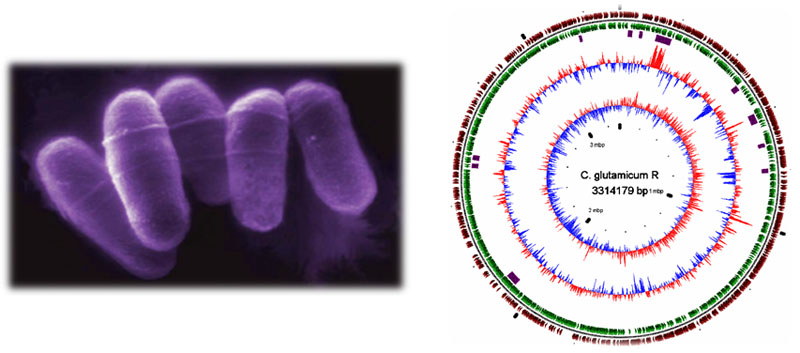- Biotechnology group>
- Core technologies>
- Corynebacterium glutamicum
Core technologies
Corynebacterium glutamicum
In 1950s, Corynebacterium glutamicum was firstly isolated by Kinoshita et al. in a screen for microorganisms which secrete L-glutamate. C. glutamicum is a Gram-positive, nonpathogenic, non sporulating bacterium which belongs to mycolic acid containing actinomycetes. This microorganism has been widely applied in the industrial production of numerous metabolites, including amino acids, nucleic acids, and organic acids. C. glutamicum is particularly useful for large-scale production of L-glutamate and L-lysine. Nowadays, more than 2 million tons of L-glutamate as well as 1.5 million tons of L-lysine per year are produced using this bacterium.
C. glutamicum does not produce L-glutamate under normal growth condition while L-glutamate production is induced by treatments leading to the alternation in membrane tension e.g. biotin-limited conditions, fatty acid ester surfactants or penicillin treatments. Although this microorganism is commonly cultivated under aerobic conditions, we found that C. glutamicum cells packed to a high cell density under oxygen-deprived conditions remain metabolically active despite cessation of cellular growth in a mineral salts medium. This finding led us to develop our unique technique "Growth-arrested bioprocess". The goal of our study is to develop an innovative bioprocess for bio-fuel, organic acids, aromatic compounds, and amino acids production that is not just economical but also environmentally friendly.
Our group has so far reported the complete genome sequences of C. glutamicum R. The genome of C. glutamicum R was 3.3Mb in size and predicted the presence of 2990 ORFs encoding 'core' genes as well as genes for transcription factors, secretion proteins, sugar metabolisms, and dual-regulation systems which are characteristic among Corynebacterium sp.

<An electron microscopic image and the genome map of C. glutamicum R>
Microbiology 153: 2491-2504. 2007.
Microbiology 153: 1042-1058. 2007.
